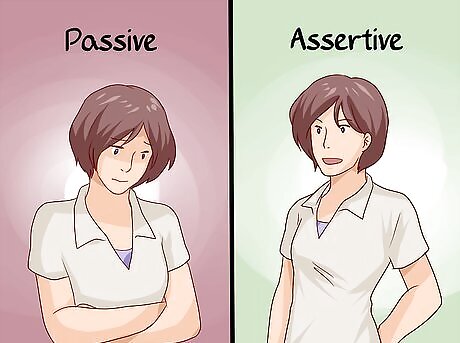
views
Laying the Groundwork for Assertiveness

Compare assertive and passive behavior. Assertiveness is not the same as arrogance. A passive person often allows his/her own rights to be violated by agreeing to things even when s/he does not want to do them, refusing to make her/his own decisions, being overly self-effacing, and refusing to communicate about thoughts and feelings honestly. An assertive person is not afraid to say “no” to inappropriate or unfeasible requests and is confident in appropriately expressing her/his feelings, needs, and reactions to others. Assertive individuals do not allow their own rights to be violated, and they do not violate others’ rights or feelings in order to express their own. Assertive individuals feel a strong sense of internal confidence (i.e., a feeling that you are acting according to your personal values and that you are doing your best). Assertiveness enhances emotional honesty, directness with others, and interpersonal relationships. If you do not stand up for yourself or you rely on others to make all of your decisions, your interpersonal relationships are not as likely to be satisfying. Non-assertive individuals generally experience lower levels of well-being and emotional security.

Recognize assertive behaviors. Assertive behavior is as much about how you say something as what you say. Assertiveness does not mean hurting or belittling another person; instead, it is about expressing your own right to have thoughts, needs, and feelings. The following are some examples of assertive behavior: Expressing your feelings clearly. Telling others of your needs in a non-threatening manner. Avoiding name-calling, swearing, and other inappropriate expressions Communicating honestly and directly Recognizing others’ rights in communication Using cooperative statements and seeking others’ opinions An example of assertive behavior would be to tell the person who cut in front of you in line at the store in a calm voice, “I was next in line. I don’t appreciate that you cut in line like that.” If the situation were reversed and you accidentally cut in line, an assertive behavior would be to accept responsibility and apologize: “I’m sorry, I didn’t see you standing in line. I’ll go behind you.” Asserting responsibility doesn’t mean you have to grovel or demean yourself, just that you recognize others’ needs as well as your own.

Remember that assertiveness is a practiced skill. While some people seem born more confident than others, communicating assertively and appropriately is a skill that requires time and practice to develop. This is especially true for women, who often face social and cultural pressures to refrain from using assertive behaviors and communication. Apologizing and taking responsibility is a healthy, helpful response to a failure to communicate appropriately. This helps keep the door open for future communication.

Acknowledge that you have rights. Social and cultural pressures may encourage you to believe that you don’t have the right to say “no” in certain circumstances, such as at work or with friends. If you are a woman, you may face social stigma if you behave assertively, such as being called “shrill,” “pushy,” or “angry” . However, it is important to recognize that nobody deserves to feel worthless or intimidated. You have the right to have needs, thoughts, and feelings, and the right to express them appropriately.

Recognize where you need to make changes. If you routinely feel pressured into agreeing to things at work or with friends, or if you feel depressed and powerless in your interactions with others, you probably need to work on your assertiveness in those areas. Remember that passivity isn’t actually doing anyone a favor; it can make you feel unappreciated or overlooked, and it isn’t honest with others. Try keeping a journal of times when you feel intimidated, coerced, pressured, passive, or timid. This can help you determine what areas pose the greatest problems for you, and where you should focus your assertiveness training.

Ask for help. If you know you have a problem responding assertively to situations, it’s a good idea to ask for help from someone you trust. This could be a friend, a partner, a boss, or a counselor. Describe the situation and the problem as specifically as possible, and then describe the changes you’d like to make in your behavior. For example, if you know you have a problem agreeing to doing extra projects at work without compensation, you could talk to a trusted co-worker about strategies for you to assert yourself the next time you’re asked to take on extra work. You can also practice your assertive responses with these trusted individuals before putting them into play in the problem situation. Rehearsing the situation will help you figure out how to approach the situation appropriately and may help alleviate anxiety.

Practice in low-stakes situations. It takes time and practice to become a skilled assertive communicator, and it can be very anxiety-provoking for individuals who aren’t accustomed to asserting themselves. Try out your skills in situations where you can practice assertiveness safely and without too much weight attached to the interaction. For example, if you routinely have difficulty asserting your preferences, the next time your order is taken incorrectly at a restaurant or coffee-shop, politely clarify the situation and ask that it be addressed: “I asked that my steak be cooked medium. This looks well-done. Would you please fix this?”

Check the context of situations. Sometimes, passive or aggressive individuals may think you are being arrogant when you aren't. It's important to recognize when critiques represent a misinterpretation of your behavior, and when they might be valid. To respond to these critiques, try emphasizing that you want to cooperate and collaborate, not dominate. Passive people might misinterpret assertiveness as rude because they are not used to speaking up for themselves. A passive person might see the direct, open style of assertive communication as different from how they behave and judge it incorrectly. Individuals who are passive-aggressive express their thoughts and feelings indirectly, often by attempting to mask their real feelings and punishing others through withdrawal, sulking, etc. Passive-aggression is very damaging to relationships and communication. Because they are used to hiding their feelings and expressing them indirectly, passive-aggressive people might see the honesty about your feelings that comes with assertiveness as rude or hostile. Aggressive people may be upset that assertive communicators stand up for themselves, rather than cowing to their demands. They may be accustomed to thinking of communication in terms of only what they want and need. They may even interpret assertive communication as hostile because they are used to valuing themselves more than others and expect others to treat them that way. In some cases, others may judge your behavior incorrectly due to their own prejudices or perceptions. Racism and other forms of prejudice and bias may encourage people to judge your behavior by standards that are neither accurate nor helpful. For example, in American culture the pervasive, hurtful stereotype of the "angry black woman" might encourage some to interpret any assertive communication by African American women as aggression. Women in Western societies are often expected to be "nurturers," and may be judged harshly for being assertive communicators. Unfortunately, there is not a lot you can do to change others' minds if they are set. Imbalances of power in situations can also foster misinterpretations. For example, if you are a manager of a team, it may be easier for the individuals working under you to view your actions as demanding and selfish, rather than assertive. Focus on collaboration, paying attention to others' feelings and needs, and encouraging others to express themselves. Being aware of those around you is a key way to keep your behavior assertive, rather than letting it lapse into aggression. Focus on the steps for "healthy assertiveness" in part 2 to make sure that your behavior is assertive, rather than passive or aggressive.
Practicing Healthy Assertiveness

Be an active listener. Letting people know your boundaries and feelings while at the same time allowing them space to talk, discuss, and open up about their feelings is important. Ask follow-up questions during conversations and use affirmations such as nodding, gestures, and agreements. Look directly at the person who is speaking. You needn't stare at him or her, but you should try to maintain eye contact for about 70% of the time you are listening. This helps communicate to the speaker that you're interested and paying attention. It can be easy to slip into thinking about what we will say in response to someone else's statement before the other person's even done talking. For example, if a friend is telling you about her awful day, you might begin to think about how you will tell her about your terrible day while she is still talking. Doing so means you are not focusing on the other person. If you're having a hard time concentrating on what the other person is saying to you, try mentally repeating or summarizing what they're saying to you. This will force you to pay more attention. When it is your turn to speak, try asking questions or using phrases to clarify what you heard. For example, if you have been listening to your partner explain something you did that frustrated him or her, you should clarify what you heard: "What I heard you say is _____. Is that right?" This helps keep you from jumping to conclusions or misinterpreting.

Be humble and modest. Assertiveness and humility make a fine combination. An assertive person doesn't need to shout "Me, me, me, look what I did!" from the rooftops. It is perfectly healthy to accept praise for a job well done or remind others that you made a contribution, as long as this doesn’t become boastful or focused on belittling others to prop yourself up. Showing humility doesn't mean that you are being weak or demeaning yourself. Celebrate your successes and congratulate yourself when you have done something well. Just don't put down others to lift yourself up. For example, if someone tells you that you did a great job on a presentation, don't feel as though you should reply by saying something like "Oh, it was nothing." Such a response minimizes your true effort and accomplishment. Instead, try an assertive reply that acknowledges your own effort while staying humble: "Thank you! I worked really hard on it and had some great help."

Use “I” statements. Statements that focus on what ‘’you’’ are feeling, thinking, or experiencing communicate your needs without blaming others or “mind-reading” (assuming that you know what others are thinking or experiencing). You can state feelings, such as “I like ___” and “I don’t want to ___,” as well as offer constructive criticism, such as “I feel irritated when you ___.” For example, if your colleague forgot a lunch date with you, don’t assume it’s because she doesn’t care. Instead, offer an “I” statement and follow it up with an invitation for her to share her experience: “I felt hurt when you didn’t make it to lunch. What happened?” Express your feelings as they really are. If you have been invited to an office function and you really don’t want to go, don’t say something like “Oh, I guess I’ll go, but it’s not really my thing.” Instead, say “I really don’t enjoy large crowds. I’d prefer not to go.”

Avoid using “should” or “ought.” Using words such as “should” or “ought” places a moral judgment on behavior and can feel blaming or demanding. These words are known as “categorical imperatives” and can create feelings of anger and guilt in others (or in yourself, if you’re directing the statement to yourself). For example, instead of saying something like “You should remember to take out the trash when you’re supposed to” to your child, try saying “It is important for you to take out the trash when it is your turn.” Try substituting “I prefer” or “I would like you to” for “should” statements.

Use an even, relaxed tone of voice. Avoid shouting or yelling, as these are disruptive behaviors that can cause discomfort for others and may prevent your point from being heard. Rather than raising your voice, speak in an even, calm tone of voice that sounds relaxed.

Invite others to share their thoughts and experiences. Don’t assume that you know what’s going on in a situation, or that you know best how to handle it. Instead, invite others into the conversation using cooperative phrases such as “What do you think?” or “Do you have any suggestions regarding ___?” This is particularly important if you are offering constructive criticism or sharing a negative feeling. Asking the other person to share their feelings and thoughts makes them feel as though they are important to you. For example, if you have a friend who repeatedly cancels plans with you at the last minute, tell her how you feel and then invite her to share her experiences with you: “When we make plans and you cancel at the last minute, I feel frustrated because it’s too late to make other plans for myself. I also sometimes feel as though you don’t want to spend time with me. Is there something going on?”

Avoid blaming others. Blaming others for our own flaws and mistakes is incredibly damaging to communication. Criticizing others for their own shortcomings in blaming language, especially language that generalizes, such as “You always forget to pick me up!” or “You’re such a slob!” gets in the way of productive dialogue. For example, if your employee forgot to file an important report, don’t heap on the blame and negative language; chances are, s/he already feels bad about forgetting. Instead, focus assertively on what s/he can do differently in the future: “I noticed that you forgot to file that report. When I have deadlines, I set a reminder in my calendar so that I don’t forget them. Do you think that would help you?”

Distinguish between fact and opinion. If you and another person disagree on something, don’t try to battle over who is “right.” This is especially true of situations where there is usually no “right” answer, such as an incident that hurt someone’s feelings. Using phrases such as “My experience is different” will help make room for everyone’s experience. For example, imagine that your partner comes to you and says that you hurt his or her feelings during an earlier conversation. Instead of immediately replying "I didn't mean to" or using other defensive language, first acknowledge that s/he felt the way s/he says. For example: "I'm sorry I hurt your feelings. I really didn't mean to, and I will work on not saying things that way again." As another example, remember that people have many ways of approaching life. Just because they are different from yours does not mean they are wrong. For example, imagine that your colleague is approaching a project in a way that you don't think is the most efficient. An example of aggressive communication could look like this: "That's a dumb way to do that" or "Who does it that way?" Instead, if it is your place -- e.g., you are in charge of the project, you are the other person's boss -- communicate your concerns about the efficiency assertively. "I see that you're tackling the project in X way. I have some experience with these projects, and I've found that Y way usually gets it done faster with better results. What would you think of trying it this way?" Keep in mind that it is often not your place to correct others. It's usually a good idea to refrain from imposing your opinions on others.

Be willing to explore options. Compromise is often both necessary and useful in interactions with others. Rather than adhering rigidly to your own view of or plan for a situation, express your willingness to explore other solutions to a problem. You can be assertive with your ideas and also invite others to share their own. This increases the likelihood of others feeling included and worthwhile. Others may also be more willing to collaborate than simply follow orders. For example, if you and your partner find that you’re having the same fight over and over again, ask her/him: “What can we do to help us both overcome this issue?”

Make statements clearly and sincerely. Even when you’re frustrated, avoid using sarcasm or condescension, as these are hurtful and derail communication. Instead, make clear, sincere statements about your thoughts and needs. For example, if you have a friend who is routinely late when you go out together, clearly express how this makes you feel without being sarcastic. A poor response would be: “Oh, wow, what a surprise. At least you’re only missing the first half of dinner this time.” Instead, try something like this: “When we make plans and you don’t arrive on time, I feel as though our time together isn’t a priority for you. I would enjoy our outings more if you arrived on time when we’ve planned to do something.”

Use assertive body language. A lot of communication is non-verbal, and how you use your body will help set the tone for your interactions with others. You can use body language to set others at ease and to communicate what you’re feeling. Examples of assertive body language include: Direct eye contact. Aim for the 50/70 rule: maintain eye contact for at least 50% of the time while you’re speaking, and 70% of the time while the other person is speaking and you’re listening. Relaxed, smooth movements. Assertive body language isn’t tense, shut-down or withdrawn; it moves steadily and smoothly. Avoid gestures such as pointing; use an open palm instead. Try not to fidget. Open posture. Stand with your shoulders back and your body turned towards whomever you’re interacting with. Distribute your weight evenly rather than pressing your weight onto one leg. Keep your feet between 4-6” apart, and don’t cross your legs. Relaxed jaw and mouth. Pressing your lips together tightly or clenching your jaw communicates tension, uneasiness, or aggression. Keep your mouth and jaw relaxed and use facial expressions to convey your emotions (smiling when happy, frowning when upset, etc.)
Avoiding Arrogance

Compare arrogance to assertiveness. While assertiveness is a way of standing up for your own thoughts and needs, arrogance is an aggressive, overbearing way of thinking and behaving that violates others’ rights and demeans others in order to build up one person. While arrogant individuals do express their ideas and needs, they do so at the expense of others. Arrogant individuals tend not to accept personal responsibility for flaws or mistakes. Arrogant individuals often have a very external sense of confidence (i.e., they base their opinions of themselves on how others think of them). While this type of confidence isn’t negative on its own, it can cause arrogant individuals to prioritize their own self-worth over the feelings of others. Arrogance is a form of aggression that often makes others feel extremely uncomfortable, even upset or torn-down, after interacting with the arrogant person. If they feel threatened or arrogant, arrogant people will usually attack or blame others.

Recognize arrogant behaviors. Arrogant behavior also expresses thoughts, needs, and feelings, but it does so in a way that disrespects and/or demeans others. While the main idea of an arrogant statement could be the same as an assertive statement -- for example, “I don’t want to do that” -- arrogant behavior does not communicate empathy or responsibility. Here are some examples of arrogant behavior: Using inappropriate language towards others Making others feel small or worthless Using a sarcastic or condescending tone Using threats Emphasizing blame Attacking others Protecting oneself with no concern for others An example of arrogant behavior would be to yell inappropriate names or language at the person who cut in line in front of you at the store. Another example might be telling that person that they are stupid and threatening them if you see them again. If the situation were reversed and you accidentally cut in line, an arrogant behavior would be to shift the blame to the other person or use a condescending tone: “Well, if you didn’t want me to cut in front you should have made it more clear that you were in line.”

Don’t belittle or demean the other person. Putting down or belittling the other person will shut down productive communication. Even if they have made a mistake or hurt you, avoid using insults or demeaning language. For example, an arrogant communication with your roommate would be: “You’re such a pig! Why can’t you keep this place clean?” An assertive communication would be: “What you do with your personal space is your own business, but I would like for you to work to keep our shared space neat and organized.”

Listen to the other person’s viewpoint. Arrogant individuals are committed to making a situation all about themselves: how they feel, how they think, how they experience a situation. Avoid arrogance by listening to others when they talk about their thoughts, needs, and feelings.

Avoid “you” statements. “You” statements make claims that you may not be able to support. You can only talk with confidence and accuracy about the actual facts of a situation -- such as what time an appointment was set for -- and your personal feelings and experiences. Use “I” statements whenever possible, and talk about the facts of a situation rather than making statements about the other person’s intention. For example, avoid blaming language such as "You're making me so angry!" Use “I”-focused statements instead, such as “I’m feeling frustrated right now."

Don’t threaten the other person. Threats and intimidation have no place in assertive communication, but they happen frequently in arrogant communication. Your goal as an assertive communicator should be to make others feel at ease because they know you will be honest with them. Threats and intimidation scare and upset others, and they kill fruitful communication. Threatening language often includes blame. For example, if you have asked your team a question and nobody has responded, an aggressive response could be, "Do you even understand the question?" Instead of offering blame and threats, reword the question: "Have I explained this concept clearly?"

Avoid using inappropriate language. In addition to the obvious suspects, such as swearing, insults, and name-calling, you should also try to avoid generalizing or totalizing language. This language often shows up as “always” or “never” statements or generalizations about another person’s intentions. For example, imagine that you have a co-worker who frequently forgets to pick you up for the carpool. An arrogant response might be if you tell him something like this: “You never remember to pick me up for the carpool, and it pisses me off. I don’t understand why you can’t remember this one simple thing.” An assertive response would be more like this: ”In the past week you’ve forgotten to pick me up for the carpool twice. I feel frustrated and anxious when you forget me because I worry that I’ll be late for work. Will you try harder to remember to pick me up? If not, I will need to make other arrangements.”

Avoid aggressive body language. Aggressive body language sends as much of a message as the words you choose. To avoid coming across as arrogant, keep an eye on your body language and avoid using the following: Violating personal space. The “three-foot rule” applies in most public and office situations. Don’t get closer than that unless you’re invited, such as when you’re on a date or asked to help someone. Aggressive gestures. Pointing and fist clenching are big culprits here. Crossed arms. While crossed legs signal a lack of confidence, crossed arms suggest a person who is closed to communication. Clenched or set jaws. If you push your jaw too far forward or clench it, you may come across as arrogant or hostile. Taking up a lot of space. This is more common in men than women, but body language that takes up unnecessary space can come across as arrogant, rather than confident. It’s fine to take as much space as you need to feel comfortable, but don’t infringe on others.



















Comments
0 comment